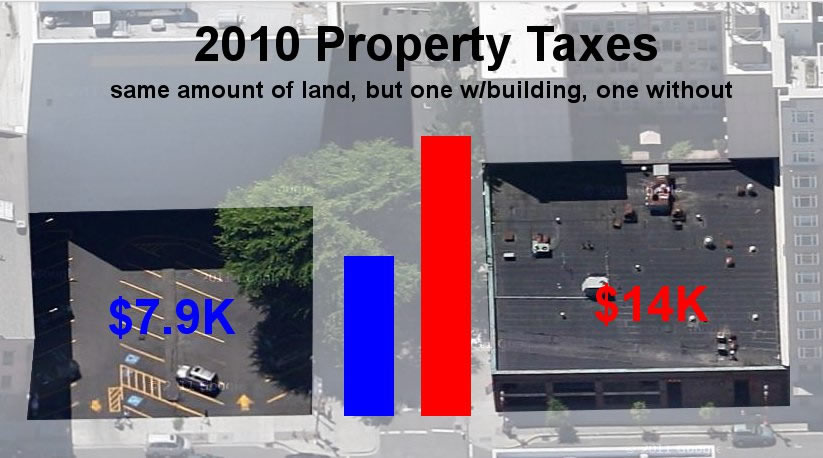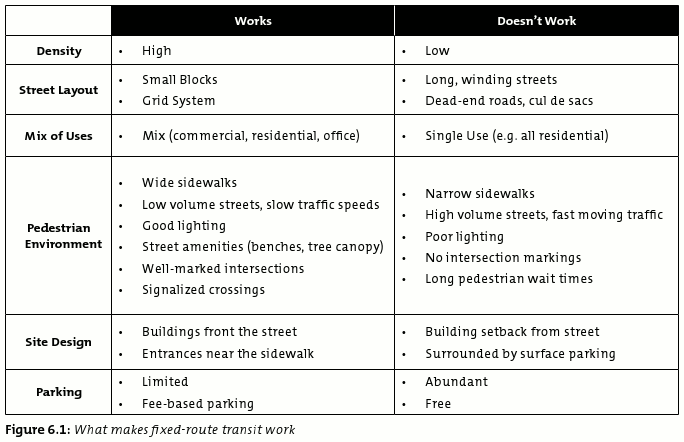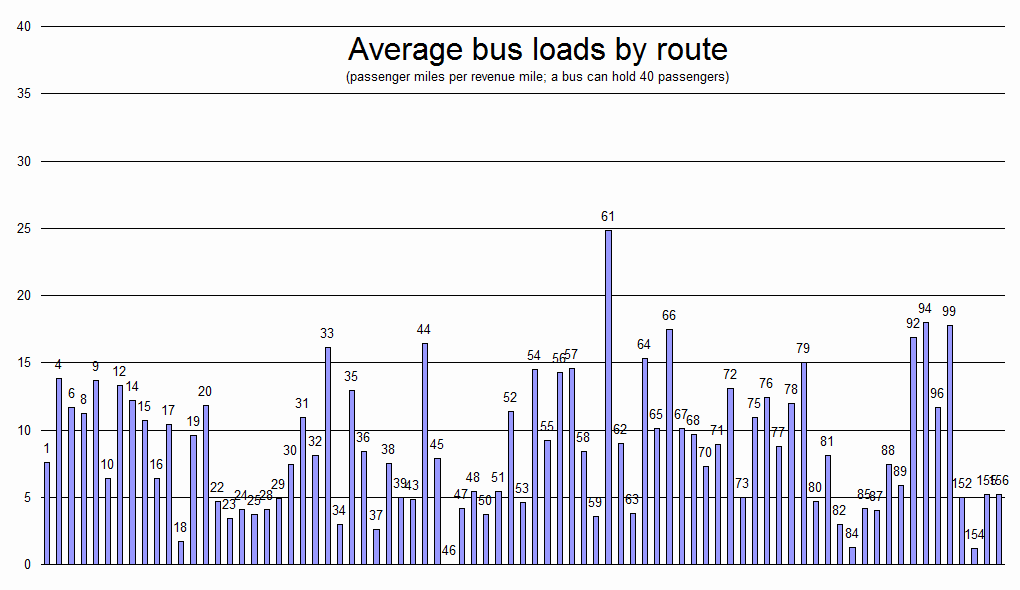Transportation / development subsidies 2
or The real reason why we have traffic congestion and "sprawl"
SUMMARY:
People who actually ride transit often pay a decent share of the cost of what they use (their seat)
Transit subsidies really because of discounted fares, higher costs and low use (too many empty seats)
Low transit use due to government development, parking, road funding and other subsidies/policies
Lots of debate about transit subsidies but little about driver subsidies, no centralized list of them
Same with urban renewal vs. suburban development
Big transit projects done to attract riders, avoid traffic; might not be needed without driver subsidies
Graphic ideas:
% of trips by car -data (non-car market should be expanded; compare to business monopolies)
PARKING:
Amount of parking needed for 40 vehicles vs. 1 bus or bus/operator going on to serve others
Transit center/base parking vs. business-provided parking (transit users pay for their parking)
Businesses often required to provide parking-Tigard example:

Use of land for parking instead of building encouraged by property tax rules
-compare taxes on this property (used for parking) to this property (used for a 1-story building)

Using free on-street parking vs. own driveway or parking lot
(not fair to those who don't use it; but efficient as it's shared)
Worker who uses free (and tax-free) parking benefit vs. one who doesn't (not fair to those who don't use it)
-Compare w/cash-out for having insurance
 from here
from here
Mode share where people have to pay for parking vs. place with good transit, etc too but free parking
TRANSIT COSTS:
Pie chart w/fare revenues, discounts (source), health care, other subsidies
(some subsidies go for social service; other riders shouldn't have to pay for those)
Based on budget %:
Based on system fare recovery ratio:
Based on operations fare recovery ratio:
Revenue, cost of transporting user of discounted fare vs. adult (cost is the same but revenue is less)
-Discounts should be paid for by society, like with food benefits and other welfare
Cost of lift/ramp, extra space, extra time to transport person w/mobility device vs. discounted fare
An adult rider paying for their fare plus the discounts given to other riders (needed if fares are to pay 100%)
$0 tolls vs. fares, time/hassle costs of transit (transit looks expensive because driving is "free")
-especially true when transit, etc is poor
Revenue from bus full of people vs. bus w/few people (full buses generate lots of revenue)
-Cost-per-ride vs. ridership graph?
-usage of TriMet buses needed to break even: 15 min trips*$2 seat hour
Transit riders responsible for cost of using their seat, auto users responsible for cost of entire car
-don't have control over whether other seats are empty or full
High % of money going to health care due to high amount of labor used
-as % of service hour cost
Only needing 18.4% of population to purchase all-zone pass to cover system costs: $322857768/1663222 people(?)*88/month*12 months
-or 23% to purchase an annual 2-zone pass, or 20% for all-zone
-or 13.3% to purchase 2 2-zone tickets a day
-expenses per resident of just $194 a year
-FY2010 data
TRANSIT RIDERSHIP:
People not having a serious, feasible transit option (can't expect what's not realistic)
Great transit in nowhere getting little ridership (how ridership needs to come first with transit)
Ridership on great transit in poor development still not great (low-ridership not just because of poor transit/chicken vs. egg)
-Poor infrastructure discouraging people from walking to transit; page 77 of TIP

Lower-density development limiting potential ridership in route corridor
Lower-density development making transit trips longer, costlier

New suburban development requiring new service; redevelopment can use existing service
Lower-frequency transit discouraging cheaper, shorter trips

RAIL PROJECTS:
Money being taken by Feds and can only be returned for transit projects-"free" $ (distorts decisions)
Competition to freeways, subsidized transit-unfriendly development
-Freeways don't benefit neighborhoods as they aren't used for property access
Cost per capacity, number of operators vs. bus; ability to handle surge loads
Lincoln Tunnel XBL/PABT comparison (MAX is medium capacity, but high capacity not needed)
67 buses to westside before MAX vs. ~20 trains afterwards (reduced labor need)
Sunset with buses before vs. Sunset w/no buses, plus MAX afterwards (MAX expanded capacity)
MAX attracting more riders than just former bus riders
Amount of buses needed today to handle MAX load
Road congestion making separate right-of-way needed
DEVELOPMENT:
Money being taken from older neighborhoods in school district & given to new schools
City vs. suburban school district enrollment histories
(Families moving because subsidies make it look cheap; not a good use of tax dollars)
How ADUs, densification is prohibited (property owners can't increase efficiency if they want to)
Decreased trans budget allowing for increased housing budget; natural pearl district
Land above single-level housing development being wasted
Suburban "flight" due to subsidies leading to blight, argument for urban renewal
Taxes, cost of urban vs. suburban pieces of same-sized land
Mortgage interest deduction, other subsidies/policies suburban housing
Compare cost, catchment area for Safeway in Pearl or downtown vs. suburban one
-for store, own building+cheap parking lot vs. costlier(?) building shared w/others above
-land more expensive, but less needed
-parking costlier but less needed
Compare land, other costs of parking lot vs. rooftop parking
Increased density resulting in increased taxes, even though the land area is the same
INFRASTRUCTURE/SERVICE USAGE:
Garbage, mail or other service making 1 vs. 5-10 stops for 5-10 people, but cost the same
-or less vs. more people being served by a single stop
-extra costs made to look less because of road subsidies
Likewise, higher amount of pipes and wires needed beyond same-sized "arterial" pipe/wire
Longer vs. shorter transit ride to Xth house but same price (transit subsidy is a development subsidy)
-or less vs. more people being served by identical route
Extra LIFT, school bus usage (compare districts) for lower-density, un-walkable area
Pearl district streets about as wide as suburban streets, but still not congested (much more efficient use)
Lack of growth containment causing increased need for infrastructure/service subsidies
-better to charge people what they use/cause and let them live how/where they want
Increased density resulting in increased taxes, but not increased needs
ROADS:
Amount of lane space needed for 40 vehicles vs. 1 bus, or 40 bikes/walkers
Maximum amount of people 2 cars can carry in the space of 1 bus (carpooling has limits)
Carpooling requiring finding other people who are both willing, able (practicality is limited)
Another driver usually meaning another car; not so w/transit
Money being taken from sewer payers (property owners) and used for road runoff
Money being taken by Feds and can only be returned for highway projects-"free" $ (distorts decision)
Federal highway funding came first before transit funding: Federal_Aid_Road_Act_of_1916
-"Under the Act, federal funding was provided for rural post roads on the condition that they be open to the public at no charge"
Money being taken from property owners: MSTIP, various city "utility" fees
-Airport Way built w/subsidy? (both trans/devel); Clackamas Town Center urban renewal
Auto traffic dominating roadway (creates need for separate bike lanes, sidewalks)
-Traffic, bikes, walkers using same space on campground roads
-sidewalks, bike lanes as mitigation
Poor infrastructure/development discouraging/preventing biking, walking (can't expect what's not realistic)
Bikes/walkers should get 100% credit for any tax for trying to be healthy
If gas taxes went first to gas-related costs (e.g. pollution, oil defense, industry subsidies) there would be nothing left for roads (roads are essentially free to use)
